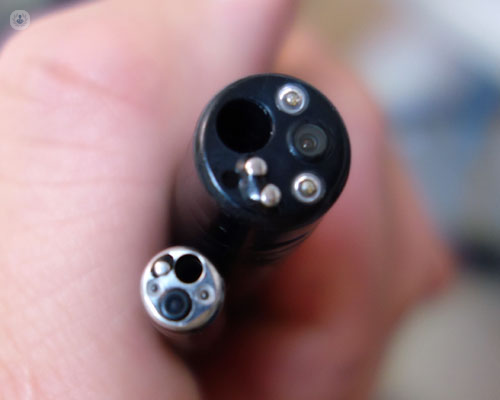

What is a fibroscopy?
Fibroscopy is an endoscopic examination used especially in otorhinolaryngology. A flexible fibre-optic instrument connected to a cold light source, a camera and a monitor are used to directly examine the cavities of the body.

What does a fibroscopy involve?
Fibroscopy involves introducing a camera with a light source into the cavities to be examined and is used especially for the respiratory tract (nose and mucous membranes, and throat). With the fibrescope connected to a camera, the specialist will be able to illuminate, examine and see the inside of the nose, pharynx and larynx in order to make a more precise diagnosis.
Why is fibroscopy performed?
In otorhinolaryngology, fibroscopy is used to examine the nose, rhinopharynx, nasopharynx, hypopharynx, and larynx. This allows for a more accurate diagnosis. The technique has a specific name depending on the area to be examined. Thus, a nasal examination with fibroscopy is called nasofibroscopy; examination of the larynx, fibrolaryngoscopy; and examination of the entire upper airway is called nasofibrolaryngoscopy.
Specifically, it is used for people with throat, nose or ear problems. Fibroscopy is frequently performed for the diagnosis of sinusitis, stuffy nose, sleep apnoea, tumours, nasal polyps, deviated nasal septum, dysphonia, nodules, polyps, vocal cord cysts or tumours, and gastroesophageal reflux.
Less common applications include examination of the glottis and trachea and the main bronchi in people with a tracheostomy cannula.
Preparing for a fibroscopy:
In principle, no special preparation is necessary before undergoing fibroscopy. If you have a particularly sensitive gag reflex, the specialist will apply some topical anaesthetic spray (though this is not usually necessary).
What do you feel during the examination?
Fibroscopy causes a small amount of discomfort because the fibre rubs slightly against the nasal or pharyngeal mucosa. In most cases it is tolerated and can be performed without anaesthetic. It does not cause choking and doesn’t usually cause nausea. However, if the area is sensitive or if you have a severe gag reflex, some anaesthetic spray may be required.
Meaning of abnormal results:
Fibroscopy can be used to diagnose respiratory tract dysfunctions or pathologies. Based on the results, the specialist performing the examination will consider the best treatment. As this examination is highly precise, it allows the specialist to clearly identify any problems with the throat, nose, larynx or pharynx.
